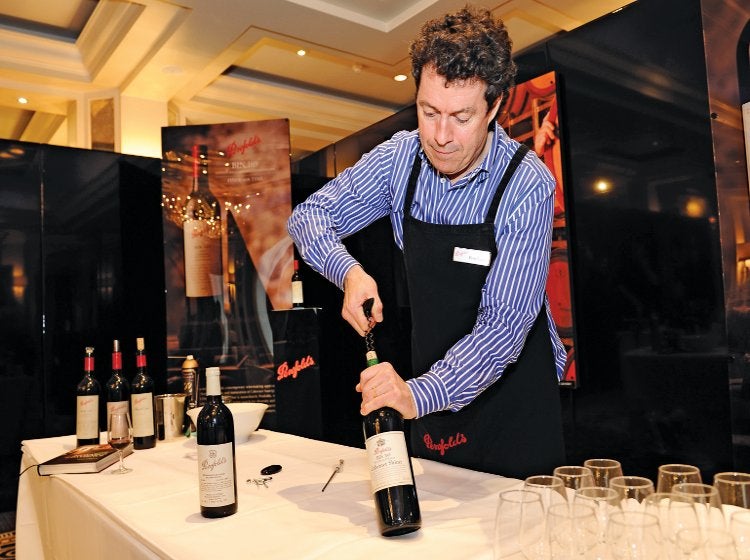
On October 22, 2013, Penfolds held its latest Recorking Clinic in the ballroom of the Berkeley Hotel in London’s Knightsbridge- a classy setting for what is surely the wine world’s most high-class after-sales service. More than 230 bottles of wine from Penfolds’ range were submitted for a kind of checkup. The service is free, regardless of where the wine was purchased, and bottles need a mere 15 years of age in order to qualify for the vinous equivalent of a full medical.
The litmus test for head winemaker Peter Gago and his team is the ullage. If the levels are still very high, the bottle will be deemed healthy and denied any treatment. Too low, and the bottle will be judged beyond redemption and sent packing with a white dot. “People have cried lots of times,” recalls Gago. Anything in between, and the Penfolds team gets to work reconditioning with the help of numerous instruments, gases, and hi-tech machines worthy of an operating room.
Several types of corkscrew were on hand, including the Ah-So, a twopronged device often used for extracting old corks. However, if the wine is deemed to be in need of (and worthy of) recorking, the Penfolds winemakers’ preferred method is the careful insertion of two basic T-shaped corkscrews, so that the helixes are very slightly angled toward one another, which seems to hold the cork together as it is removed. Once the cork has been removed, a small amount (no more than 2 percent of the bottle’s contents) is tasted by the winemaker and the owner.
Then the wine is topped off and the remaining gap filled with inert gas before the bottle is recorked. In place of the dreaded white dot, the bottle is labeled with the date of reconditioning and a unique reference number linking it to a Penfolds database for future verification.
Dreaded white dots
Surprisingly, Gago tells me that the white dots, though dreaded, often end up being welcomed by the owner. “Most people who get a white dot leave happier because we’ve effectively given them permission to drink the wine.” It’s all about “goodwill,” says Gago, clarifying, “The number-one objective of all these Recorking Clinics is altruistically to get people to drink.” Altruistic because, “these things cost a fortune.” To host the events, dealing directly with the end user, “costs us millions,” confesses Gago-not least because the wines submitted are replenished with the most recent bottled vintage of the same cuvée, free of charge. So, in 2013, older Granges around the world were spiked with nothing less than the 100-point 2008 Grange. (We were treated to a taste: It has a sweet, pruney nose, displaying sugared blackcurrants, with a fresh, green aspect and a touch of licorice, followed by black cherry on the palate, which is fresh, lovely, sweet, smooth, and above all, balanced, with an intense, tannic finish). “Some people won’t have come last year as they were waiting [for the 2008],” supposes Gago.
The so-called clinics have been going since 1991, but this was the first to be held in London for five years and was a relatively modest affair. In Australia, eight winemakers spend up to ten days in cities across the country. “By the end, we have skin peeling off our lips,” bemoans Gago. To date, around 120,000 bottles have passed through the clinics, including in Asia. The first mainland China edition took place in Shanghai last April.
In China, Penfolds prefers to use the expression “Authenticity Clinic,” in response to concerns about fakes there. However, Gago says that they “almost never” see counterfeits at the clinics. “We have had cold tea or coffee [in the bottle],” Gago says, though he believes this to be the entirely innocent result of a relative having filling up an empty bottle for subsequent display in the house and his inheritor being unaware of this ruse.
Countering counterfeits
The Penfolds brand is certainly not immune to faking, though. In a lecture in Hong Kong in November last year, expert Maureen Downey showed an image of “Penfoids,” in the same red font. Other sightings have been reported of “Panfaids.” One would like to think these would never make it as far as a Recorking Clinic, but any more convincing counterfeits being presented for reconditioning would happily be weeded out of the system by Penfolds’ own winemakers.
In reality, a more common source of controversy is the winemakers’ verdict on whether the bottle qualifies for reconditioning. Gago would spend hours going back and forth with customers to explain that the level was high enough and the wine best left untouched, or conversely too low for it to merit the attention. Until, that is, Penfolds introduced a simple paper ullage measure to hold up against the bottle and cast the final verdict.
The condition of the wine is inextricably linked to the wine storage history, with the ullage guide equating “no reduced ullage” to the wine having been “well cellared.” Gago cites movement as a key factor, noting that “rarely does a case stay in one place anymore” and explaining in scientific detail the ill effects of heat and, moreover, “oscillating temperatures,” causing the wine to expand and contract as chemical processes take place, “changing the pressure in the bottle” and therefore compromising the cork’s effectiveness as a seal against the oxygen outside.
But the Recorking Clinics are not only about getting a nice new cork in your prized bottle of Penfolds; they’re also about the human contact, getting to meet some of the winemakers- perhaps several times over the years- and sharing the story of that bottle. “This is tangible, overt, emotional, engaging,” says Gago, declaring the clinics “a sociological experience.” Penfolds is currently planning to holds clinics in Australia, Canada, and the United States in 2014.






